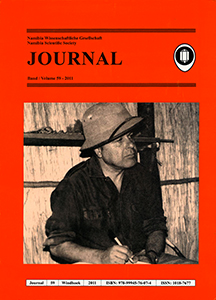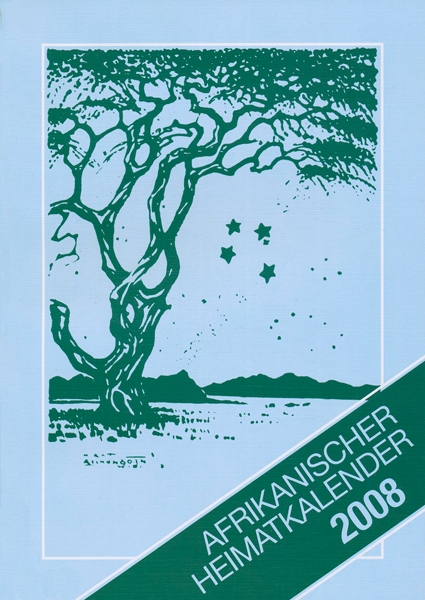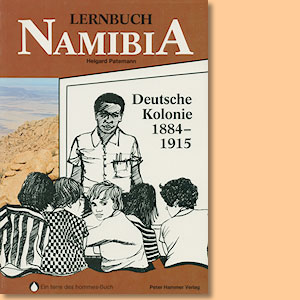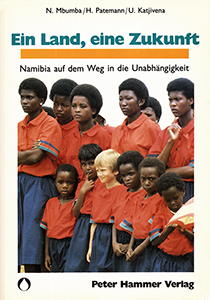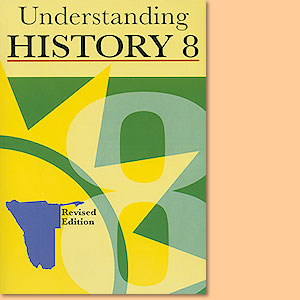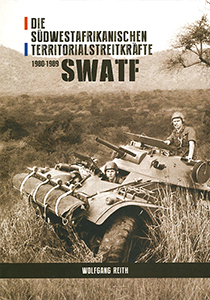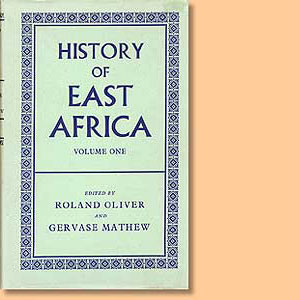Understanding History, Vol. 9, by John J. Katzao; Nangolo Mbumba; Bryn O'Callaghan; Helgard Patemann; Eddie I. van Staden; Davy H.A. Tail
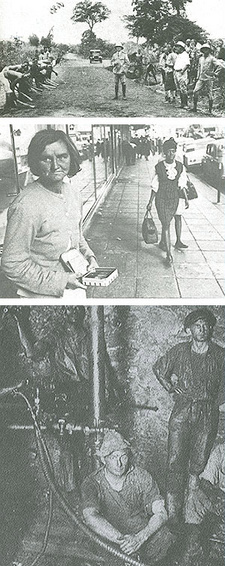
Understanding History, Vol. 9, by John J. Katzao; Nangolo Mbumba; Bryn O'Callaghan; Helgard Patemann; Eddie I. van Staden; Davy H.A. Tail.
Understanding History, Vol. 9 is a school book made in Namibia, by John J. Katzao; Nangolo Mbumba; Bryn O'Callaghan; Helgard Patemann; Eddie I. van Staden; Davy H.A. Tail.
Introduction: To the teacher
This book was compiled for the New Namibian Curriculum for Junior Secondary History. It is the second of a series which is to deal with the content for the three school-years in this phase. In editing this book we have endeavoured to pay particular attention to those points of view and subject areas which have been dealt with inadequately in Namibian textbooks before independence. This concerned above all an African perspective of history. Nevertheless, the editors acknowledge that the content of Namibian history is not as extensive as they would have liked. Namibia is in the process of transforming its hitherto colonial society. There is not much room at such a time for conducting extensive research into history. It should be noted that not only curriculum revision but also textbook revision is a continuous process. Teachers and students are expressly encouraged to turn to their own history and to bring it into the classroom. There are many sources for the studying of history, few of which are considered worth taking into account by the colonial state. The book aims to guide Junior Secondary students in learning, amongst other things, to critically analyse historical information. Furthermore, the process of reconciliation and nation-building should be supported through the teaching of history. The book begins with a chapter on the Namibian system of government. It is up to the teachers to decide how and to what depth this text is to be studied. It may be more meaningful to deal with this chapter at a later stage of the school-year. The book is divided into three main parts. The first part deals with the history of Namibia under colonialism up to the Second World War. Colonial history of Africa (the second part) shows strategies of oppression and responses from the oppressed. Part three deals with philosophies, and the many changes the world and its people underwent, during the period of European expansion.
Although the history of Namibia, of Africa and of the World are presented one after the other, the teacher is free to make cross-references. These can open up interesting perspectives. Our work has been topic-oriented, i.e. we have chosen themes in accordance with central issues which could at the same time be seen as exemplary. A rigid chronological form would have prevented inter-relationships from becoming clearly apparent. Nevertheless the chapters follow a loose chronological order. All chapters follow the same basic structure. At the beginning we give a summary of the chapter and list the main concepts, people, and events to be dealt with. This should help teachers to ascertain the desired learning results at a glance. At the end of each chapter there are suggestions for exercises and project work and the improvement of students' word power.
To the student:
This textbook has been designed to give you basic knowledge about particular events and concepts
• show you how historical evidence is collected from various sources of information
• show you how historical information can be presented
• widen or deepen your understanding of the heritage we have received from those who have lived before us
• help you to better understand your place in Namibia, Africa and the World
• help you to prepare for tests and examinations.
You will find:
• a brief summary and a list of new concepts at the beginning of each chapter, drawing your attention to the key issues involved
• much original evidence such as photographs, documents and eye-witness accounts in the chapters themselves
• exercises and suggestions for project work at the end of each chapter, which we hope will be interesting and useful on your journey into history
• many diagrams and maps for your better orientation
• a vocabulary to assist you with language learning
• an index which easily and quickly helps you to find nearly all personal and place names mentioned in the book.
Content: Understanding History, Vol. 9
Maps Introduction
The Constitution of the Republic of Namibia
Part 1: Namibia
The Germans take control
Introduction
Borders
Internal conflicts
Herero-German conflict
Colonial intruders Early resistance to German rule
Hendrik Witbooi
The resistance of 1896
Ruin of the Namibian economy
Resistance in the north
Armed clashes The War of National Resistance 1904-08
Causes of the war
The Herero uprising
The north joins the war
The guerilla struggle in the south Land confiscation and migrant labour
Economic problems after the war
Colonial administration
Settlers
Mines and railways
Migrant labour South Africa takes control
South Africa occupies Namibia
The Battle of Naulila
Resistance in the north
The League of Nations mandate
The mandate in practice
Resistance in the south
Cultural associations
White administration
Part II: Africa
6 European rivalries and the Partition of Africa
Imperialism and colonialism
Why Europe wanted colonies in Africa
The French and the Belgians in the late 1870s
The British in Southern Africa and Egypt
Germany 1884
The Berlin Africa Conference 1884—85
7 Government in colonial Africa
Imposed frontiers
From military to civilian rule
Indirect rule and assimilation
Accommodation
8 Economy in colonial Africa
Land and labour
The purposes of new taxation
Export crops and food
The contradictions of "progress"
9 A case study: Afrikaner domination in South Africa 1919-48
Growing African resistance
The Land Act of 1913
South African coloureds and Indians
The "poor white" labour problem
The Industrial and Commercial Workers Union
The African National Congress (ANC)
White South African governments 1910-1948
10 A case study: British rule in Zimbabwe
Colonial occupation
Mining and forced labour
Land expropriation
The state, cheap labour and settler capitalist agriculture
The new settler regime and land confiscation
African conditions in urban areas
African protest in the 1920s and 1930s
11 Movements of religious protest, Pan-Africanism and Negritude
Independent churches and religious protest movements
Islamic protests
The Pan-African movement: Origins and early aims
Negritude
Part III: The World
12 Great changes in government, 1600-1815
Dynasties and divine Kings
Absolute monarchs in Europe
Parliament and the English Revolution
The American Revolution
France on its way to a Revolution
Thinkers about government
The French Revolution
Napoleon as Emperor
13 Revolutions in trade, industry and society
Economic developments during the European expansion
Industrial Revolution, 1750-1914
The economic and social consequences of industrialisation
Karl Marx's analysis of the class struggle
14 People in struggle (I): Towards democracy and unification in Europe, 1815-1914
From representative to democratic government
Towards democracy in Britain
Nationalism in 19th-century Europe
Nationalist struggles in Spain and Portugal
Nationalist struggles in Greece, Belgium and Italy
Unification in Germany
Repression and reform in Russia
15 The Christian reformation and world faiths
The Reformation
The Counter-Reformation
Significance of the Reformation
Hinduism
Buddhism
Confucianism
16 Renaissance and expansion, enlightenment, liberalism and nationalism
The Renaissance
Expansion
Enlightenment
Liberalism
Nationalism
17 People in struggle (2): Resistance to colonialism
Latin America
Asia and the Europeans
India
China
Japan
Vocabulary
Source
Books
Index
This is an extract from the school book: Understanding History, Vol. 9, by John J. Katzao; Nangolo Mbumba; Bryn O'Callaghan; Helgard Patemann; Eddie I. van Staden; Davy H.A. Tail.
Book title: Understanding History, Vol. 9
Editors: John J Katzao; Nangolo Mbumba; Bryn O'Callaghan; Helgard Patemann; Eddie I van Staden; Davy H A Tail
Publisher: Longman
25th impression, Windhoek 2005
ISBN 99916-1-010-3
Softcover, 18x24 cm, 192 pages, numerous bw-illustrations
Katzao, John J. und Mbumba, Nangolo und O'Callaghan, Bryn und Patemann, Helgard und van Stad im Namibiana-Buchangebot
Understanding History, Vol. 9
Understanding History, Vol. 9 is a Namibian Junior Secondary Textbook. History of colonial Namibia, Africa and the World.
Gourmet Safari: A gastronomic journey through the wonders of Africa
Gourmet Safari: A gastronomic journey through the wonders of Africa covers the food that is served throughout a day on safari.
Journal 59-2011 (Namibia Wissenschaftliche Gesellschaft)
Dies ist die 59. Ausgabe des Journals der Namibia Wissenschaftlichen Gesellschaft von 2011.
Afrikanischer Heimatkalender 2008
Afrikanischer Heimatkalender 2008: Seit 1930 Botschafter christlicher Werte in Namibia, mit vielen interessanten landeskundlichen, geschichtlichen, politischen und kulturellen Beiträgen.
Lernbuch Namibia. Deutsche Kolonie 1884-1915
Kooperationsprojektes zwischen der Universität Bremen und dem Institut der Vereinten Nationen für Namibia
Ein Land, eine Zukunft. Namibia auf dem Weg in die Unabhängigkeit
'Ein Land, eine Zukunft. Namibia auf dem Weg in die Unabhängigkeit' will mit zahlreichen Beiträgen über Ideologie und Praxis des Kolonialsystems in Namibia sowie über politische und gesellschaftliche Utopien und Alternativen informieren.
Understanding History - Grade 8 Revised edition
Understanding History - Grade 8 Revised edition - includes all historical topics contained in the Current Junior Secondary History syllabus.
Weitere Buchempfehlungen
Zoo Park: A History. Documentation of the former Zoo Park (1887-1958) in the center of Windhoek.
The original Zoo Park architecture (1887-1958) has vanished. The Zoo Park is located in the center of Windhoek, this is its history documentation.
Die südwestafrikanischen Territorialstreitkräfte (SWATF) 1980-1989
Erstmals in Deutsch beschrieben: Die Geschichte der südwestafrikanischen Territorialstreitkräfte (SWATF) von der Gründung 1980 bis zur Auflösung 1989.
History of East Africa Volume 1
One of three standard setting Volumes in which the history of East Africa is studied from an African as well as from a European standpoint



